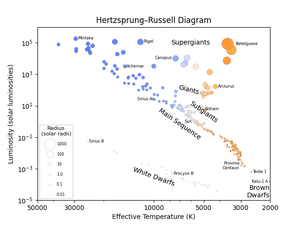Glossary term: Supergiant Star
Description: Supergiants are the largest and most luminous stars. They can be several hundred times larger than the Sun and many thousand times more luminous. They occupy the top region of the Hertzsprung–Russell diagram with absolute visual magnitudes between −3 and −8. The temperature range of supergiant stars spans from about 3400 kelvins (K) to over 20,000 K. They are either massive stars or are in a very late phase of stellar evolution. Supergiant stars can be identified on the basis of their spectra, with distinctive lines sensitive to high luminosity and low surface gravity: these spectral lines are narrow compared to the width of lines in smaller stars. Typical examples of supergiant stars are Betelgeuse in Orion and the Cepheid variables.
Related Terms:
See this term in other languages
Term and definition status: This term and its definition have been approved by a research astronomer and a teacher
The OAE Multilingual Glossary is a project of the IAU Office of Astronomy for Education (OAE) in collaboration with the IAU Office of Astronomy Outreach (OAO). The terms and definitions were chosen, written and reviewed by a collective effort from the OAE, the OAE Centers and Nodes, the OAE National Astronomy Education Coordinators (NAECs) and other volunteers. You can find a full list of credits here. All glossary terms and their definitions are released under a Creative Commons CC BY-4.0 license and should be credited to "IAU OAE".
If you notice a factual error in this glossary definition then please get in touch.
Related Diagrams
Hertzsprung-Russell diagram
Credit: IAU OAE/Niall Deacon
License: CC-BY-4.0 Creative Commons Attribution 4.0 International (CC BY 4.0) icons









